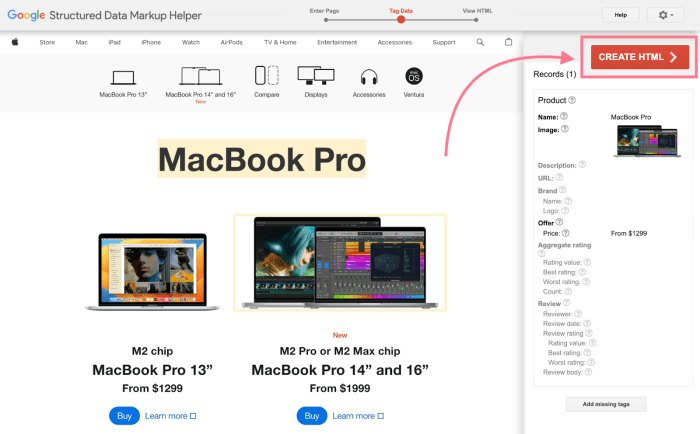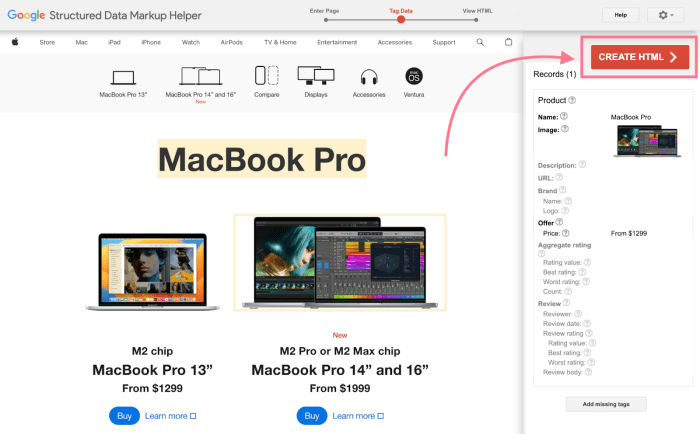How to get rich snippets? This guide dives deep into the world of search engine optimization, revealing the secrets to unlocking richer, more engaging search results. Imagine your website content standing out from the crowd, attracting more clicks and boosting your visibility. We’ll explore everything from understanding the fundamentals of rich snippets to troubleshooting common issues and optimizing your content for maximum impact.
Get ready to transform your WordPress site into a search engine powerhouse.
This comprehensive guide will walk you through the essential steps to implement rich snippets on your WordPress site, increasing your organic search ranking and user engagement. We’ll cover various aspects, from understanding the different types of rich snippets to implementing schema markup and testing the results.
Understanding Rich Snippets

Rich snippets are enhanced snippets of information displayed in search engine results pages (SERPs). They go beyond the standard title and description, providing users with a more comprehensive preview of the content available on a web page. This extra detail can significantly improve your website’s visibility and user engagement. They provide a richer experience, allowing users to quickly grasp the essential details before clicking through.Rich snippets can include various types of data, such as star ratings for products, ingredients for recipes, or author information for articles.
This additional information makes search results more informative and compelling, potentially leading to higher click-through rates.
Getting rich snippets involves optimizing your content for Google’s structured data markup. This means understanding how Google’s algorithms are evolving, and unfortunately, sometimes they leave us scratching our heads. Take, for example, the recent news about Google hyping AI overviews but refusing to address click-through rate (CTR) questions in google hypes ai overviews refuses to answer ctr question.
This highlights the importance of focusing on comprehensive, user-friendly content, which ultimately still helps with rich snippets.
Types of Rich Snippets
Rich snippets come in various forms, each designed to enhance the search experience for specific content types. This variety allows search engines to present results tailored to the user’s query.
- Recipe Rich Snippets: These snippets display key recipe information, including ingredients, preparation time, cooking time, and serving size. This provides a quick overview of the recipe’s details without requiring users to navigate to the website. For example, a recipe for “Chocolate Chip Cookies” might display the ingredients (flour, sugar, butter, chocolate chips), prep time (15 minutes), and cook time (10 minutes), in the search result, making it easy for users to decide if it’s the right recipe for them.
- Product Rich Snippets: These snippets showcase detailed product information directly in the search results. This can include product images, price, availability, star ratings, and customer reviews. For example, a search for “running shoes” might display several product rich snippets, each showing a picture of the shoe, its price, customer rating, and availability.
- Review Rich Snippets: These snippets incorporate customer reviews and ratings directly into the search results. This gives users a sense of the product or service’s quality and reputation before clicking through to the website. This can be a product review, a restaurant review, or a service review, allowing potential customers to assess the reputation and satisfaction level of a service or product.
Benefits of Using Rich Snippets
Rich snippets provide substantial advantages for website visibility and user engagement.
- Increased Click-Through Rates (CTR): By providing more detailed information, rich snippets often result in higher click-through rates from search results. Users are more likely to click on results that clearly highlight the relevant information they’re seeking. A study by Searchmetrics found that websites with rich snippets had a significant improvement in their CTR compared to those without.
- Improved Website Visibility: Rich snippets can make your website more prominent in the search results, increasing visibility and driving more traffic. The added context and information make your listings stand out from the competition.
- Enhanced User Experience: Rich snippets provide a more informative and user-friendly experience. Users can quickly understand the content of a page before clicking, reducing the need to navigate to the page. This improved user experience often leads to higher user satisfaction.
- Positive Impact on Organic Search Rankings: While not a direct ranking factor, rich snippets can indirectly impact rankings by improving click-through rates and time on site. Higher engagement metrics can signal to search engines that your content is valuable and relevant, which could contribute to a better ranking position over time. A study by Moz showed a correlation between higher click-through rates and better search engine rankings.
Identifying Rich Snippet Opportunities: How To Get Rich Snippets
Unlocking the potential of rich snippets requires understanding the opportunities that exist for your content. Rich snippets are more than just pretty displays; they significantly improve click-through rates by providing users with more context and information directly on the search engine results page (SERP). This section delves into the key elements that contribute to rich snippets, enabling you to identify and optimize your content for enhanced visibility.Identifying which content types are suitable for rich snippets is crucial for maximizing your efforts.
By recognizing patterns and leveraging specific structured data markup, you can significantly boost your website’s visibility in search results. This approach not only enhances user experience but also increases organic traffic to your site.
Common Elements Contributing to Rich Snippets
Structured data markup is the foundation of rich snippets. It provides search engines with a clear understanding of the content on your pages, enabling them to display more informative results. Common elements include schema.org vocabulary, which helps define the type of content on a page, and specific tags that provide details about items like products, reviews, recipes, and events.
Getting rich snippets involves optimizing your content for search engines, but understanding how Google’s AI works is key. Recent overviews like google search boss ai overviews boost click quality highlight the importance of high-quality content and structured data markup. By focusing on these factors, you’ll significantly improve your chances of earning those coveted rich snippets and boosting your click-through rate.
These tags communicate essential information about your content, such as the name, price, rating, and availability.
Discovering Eligible Content Types
Identifying content eligible for rich snippets involves recognizing patterns and tailoring your approach to specific content types. Product pages, recipes, reviews, and articles with specific details (like publication dates and authors) are prime candidates. If your site contains these kinds of content, the next step is to implement schema markup.
Finding Pages Using Rich Snippets
Several tools can help determine which pages on your site are already using rich snippets and are displaying them correctly. Tools like Google Search Console and various auditing tools provide insights into the structured data implemented on your pages. These tools often identify potential errors and offer suggestions for improvement, allowing you to pinpoint areas for optimization.
Getting rich snippets involves more than just keyword stuffing. A crucial aspect often overlooked is average page load time. Optimizing for a fast average page load time is key to user experience, and search engines reward sites that deliver quickly. This, in turn, directly impacts your chances of earning those coveted rich snippets. So, focus on both speed and quality content for the best results.
Methods to Identify Eligible Pages
Using Google Search Console, you can verify the presence of rich snippets on your pages. Search Console reports will highlight the types of rich snippets your pages are displaying, indicating successful implementation. Manually inspecting the source code of relevant pages can also confirm the presence and correctness of schema markup. By examining the HTML, you can visually identify the presence and format of schema markup.
Comparing Structured Data Markup Types
| Content Type | Structured Data Markup | Example |
|---|---|---|
| Product | Product schema | Name, price, availability, image |
| Recipe | Recipe schema | Ingredients, preparation steps, cooking time, rating |
| Article | Article schema | Author, date published, description, image |
| Event | Event schema | Date, time, location, name |
This table illustrates the different structured data markup types used for various content types. Matching the appropriate schema to your content is crucial for effective rich snippet implementation.
Importance of Correct Schema Markup
Correct schema markup is paramount for successful rich snippets. Inaccurate or improperly formatted markup can lead to search engines failing to understand your content, preventing the display of rich snippets. Validating your markup using tools like Google’s Structured Data Testing Tool ensures accuracy and proper implementation, which significantly enhances your chances of achieving rich snippets.
Optimizing Rich Snippet Content
Getting your website’s content to show up in rich snippets is more than just adding markup. It’s about crafting engaging, informative content that Google’s algorithms recognize as valuable and well-structured. This requires a deep understanding of the specific types of rich snippets you want to achieve and how to optimize your existing content for maximum impact.Optimizing content for rich snippets involves a blend of meticulous content creation and strategic practices.
By focusing on clarity, accuracy, and comprehensive detail, you significantly increase your chances of attracting rich snippet display. The better your content, the more likely it is to stand out in search results and attract more organic traffic.
Enhancing Content Quality for Rich Snippet Display
High-quality content is fundamental to attracting rich snippets. Focus on providing comprehensive information, addressing user needs thoroughly, and making your content easy to understand. This means clear language, well-structured paragraphs, and logical flow. Avoid jargon and ensure your content is accurate and up-to-date.
Optimizing Existing Content for Rich Snippets
Review your existing content with a critical eye. Identify areas where you can improve clarity, completeness, and accuracy. Look for opportunities to add more descriptive details and structured data to existing articles or product pages. For example, if you have a recipe, consider adding nutritional information or preparation time. If you have a product page, include detailed specifications and customer reviews.
Making Content Appealing and Descriptive
A crucial aspect of attracting rich snippets is making your content highly appealing to both users and search engines. Use compelling language, engaging visuals (if appropriate), and descriptive titles and meta descriptions. Ensure that your content is easy to scan and understand at a glance. High-quality images and videos can significantly enhance the appeal of your content.
Visuals should support the text and improve user experience.
Examples of Well-Structured Content
A well-structured product page might include detailed specifications (e.g., dimensions, materials, weight), customer reviews, and a clear call to action. A recipe page might include ingredient lists, preparation steps, nutritional information, and cooking time. In both cases, the focus is on providing comprehensive and easily digestible information.
- Product Page Example: A product page for a camera might include detailed specifications like megapixel count, lens type, and video recording capabilities. Customer reviews would also be beneficial, as they add social proof and user-generated content.
- Recipe Page Example: A recipe page for a cake could include a detailed list of ingredients, clear instructions for each step, baking time, and nutritional information. Images of the cake at different stages of preparation could further enhance the experience.
Importance of Accurate and Complete Data
Accurate and complete data is essential for successful rich snippet implementation. Inaccurate information will not only lead to a poor user experience but also potentially harm your search engine rankings. Ensure that all data, such as prices, ratings, reviews, and specifications, are correct and up-to-date. Regularly review and update your data to maintain accuracy.
Testing and Monitoring Rich Snippets
Getting your rich snippets displayed correctly in search results is only half the battle. Just as important is ensuring those snippets remain accurate and visible over time. This crucial step involves rigorous testing and continuous monitoring to catch and address any issues before they negatively impact your search visibility.Testing and monitoring your rich snippets is like a quality control process for your website’s search presence.
It’s about proactively identifying and fixing problems, ensuring your schema markup is correctly interpreted by search engines and displayed accurately to users. This proactive approach maximizes your chances of achieving a strong search ranking and a better user experience.
Testing Rich Snippets on Different Search Engines
Validating rich snippets across various search engines is essential for comprehensive coverage. Different search engines may interpret schema markup with subtle differences, requiring independent verification. This ensures your content displays as intended across platforms. Tools like Google Search Console and Bing Webmaster Tools provide insights into how your snippets appear in their respective search results.
Verifying Schema Markup Implementation
Accurate schema markup implementation is critical for rich snippets. Manual verification, using online validators, is a key step. These tools parse your HTML to pinpoint any errors or inconsistencies in your schema markup. Correcting errors promptly is vital for avoiding inaccurate or absent rich snippets.
Tools for Monitoring Rich Snippet Performance, How to get rich snippets
Regular monitoring of rich snippet performance is crucial for ongoing optimization. Different tools cater to this need, providing valuable data about your rich snippet presence.
| Tool | Primary Function | Strengths | Weaknesses |
|---|---|---|---|
| Google Search Console | Tracks rich snippet appearances in Google search results. | Free, comprehensive data on Google search, includes rich snippet impressions and clicks. | Limited data on other search engines, requires Google Search Console integration. |
| Bing Webmaster Tools | Monitors rich snippet visibility on Bing search results. | Provides insights into rich snippet performance on Bing. | Limited data compared to Google Search Console, requires Bing Webmaster Tools integration. |
| Schema.org validator | Validates the structure and syntax of your schema markup. | Identifies errors in your schema markup, helping ensure accuracy. | Doesn’t provide performance data, solely focused on schema validation. |
| Rich Results Test | A tool to test the rich snippet rendering on various search engines. | Simulates how rich snippets will appear on different search engines. | Limited data analysis, primarily for visual verification. |
The table above illustrates the diverse range of tools available for rich snippet monitoring. Choosing the right tool depends on your specific needs and the search engines you want to focus on.
Tracking Rich Snippet Appearances and Performance
Using these tools effectively requires understanding the metrics they provide. For instance, Google Search Console provides data on impressions (how often your snippet appeared), clicks (how often users clicked on your snippet), and position (where your snippet ranked in the search results). Regularly reviewing these metrics reveals trends and areas for improvement. Analyzing clicks and positions can identify patterns in user behavior, helping to tailor your content to better meet their needs.
Continuous Monitoring for Rich Snippet Optimization
Continuous monitoring is crucial for maintaining optimal rich snippet performance. Search engine algorithms evolve, and website content changes over time. Regularly checking rich snippet visibility ensures that your schema markup remains accurate and that your content remains in sync with search engine expectations. This proactive approach allows for timely adjustments to your schema markup and website content, keeping your rich snippets optimized and visible.
Troubleshooting Rich Snippet Issues

Getting your rich snippets to display correctly can sometimes feel like a detective game. Understanding the potential pitfalls and knowing how to diagnose and fix them is crucial for maximizing your website’s visibility in search results. This section will delve into common problems and provide actionable solutions.Troubleshooting rich snippets involves a multifaceted approach. It’s not just about the schema markup; it also encompasses the overall structure and content of your website.
By systematically identifying potential issues, you can ensure that your rich snippets are displayed accurately and consistently.
Common Schema Markup Implementation Errors
Correctly implementing schema markup is fundamental to rich snippet display. Errors in this area are frequent culprits for missing rich snippets. Inaccurate or incomplete data, structural issues in the markup, and problems with the use of structured data vocabulary can all lead to problems. Carefully validating your schema markup is essential.
- Incorrect data types: Using the wrong data type for a field (e.g., using a string where an integer is expected) can cause errors. Ensure data types align with the schema vocabulary. For instance, a product price should be a number, not a string.
- Missing or incorrect properties: Critical properties within your schema markup might be absent or incorrectly defined. Review the schema documentation to confirm you’ve included all necessary properties and that they’re correctly formatted. Missing a “reviewRating” property on a product page, for example, would prevent a star rating rich snippet from appearing.
- Syntax errors: Typos or incorrect formatting within the schema markup can prevent it from being correctly interpreted. Thorough proofreading and use of validation tools are crucial.
- Incorrect use of namespaces: Using the wrong or missing namespaces can lead to errors in schema interpretation. Always include the appropriate namespaces (e.g., `schema.org`) to ensure correct parsing.
Troubleshooting Rich Snippet Display Issues
Once you’ve addressed potential schema markup errors, you can move on to broader troubleshooting steps.
- Verify Schema Markup Validity: Use online validators like Google’s Rich Results Test to confirm your schema markup is correctly formatted. These tools can identify syntax errors, missing properties, or incorrect data types.
- Check for Canonicalization Issues: If your website uses canonical tags, ensure they don’t conflict with the structured data. Incorrect canonicalization can confuse search engines and prevent the correct data from being used for rich snippets.
- Review Website Structure: Examine the HTML structure of the page containing the rich snippet markup. Ensure that the elements containing the schema markup are properly structured and nested. Poor HTML structure can also impede proper schema markup parsing.
- Check Google Search Console: Use Google Search Console to see if any crawl errors are preventing Google from properly interpreting your structured data. Error messages in Search Console often provide valuable insights into the problem.
Example of Common Errors and Remedies
Consider a product page with incorrect schema markup for a review rating.
| Typical Rich Snippet Issue | Corresponding Solution |
|---|---|
| Missing or incorrect reviewRating property | Add the reviewRating property to the schema markup, ensuring the correct data type (e.g., integer). For example, ` |
| Incorrect use of `@type` | Confirm the correct use of `@type` in your markup. The `@type` value should match the schema vocabulary. Use `@type = “Product”` |
| Missing name property for the product | Add the `name` property for the product, providing the accurate product name. |
Ultimate Conclusion
In conclusion, mastering rich snippets is a crucial step in boosting your WordPress site’s visibility and user experience. By understanding the concept, identifying opportunities, implementing the right markup, optimizing your content, testing, and troubleshooting any issues, you can unlock a significant advantage in the search engine results pages (SERPs). This guide has provided a roadmap for achieving successful rich snippet implementation, allowing your site to shine in the competitive online landscape.






